#tp4056
Text
Lithium Battery Charger TP4056: Datasheet, Schematic, Price
The TP4056 is a highly integrated and easy-to-use single-cell lithium-ion battery charger module. It features a constant current/constant voltage (CC/CV) charging algorithm, ensuring safe and efficient charging of lithium-ion batteries. The module integrates various protection features, including over-charge, over-discharge, and over-current protection, enhancing battery life and safety.
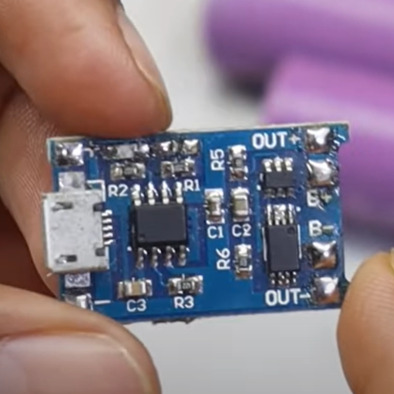
1 note
·
View note
Photo

Li-ion battery charger + voltage booster module. #tp4056 #li-ion #battery #charger #booster #module #18650 #3.7v #recharging https://www.instagram.com/p/CoH6Q5Xvd3o/?igshid=NGJjMDIxMWI=
0 notes
Text
Lithium Battery Charge Management Chip Market Analysis, Dynamics, Key Players, & Forecast till 2033
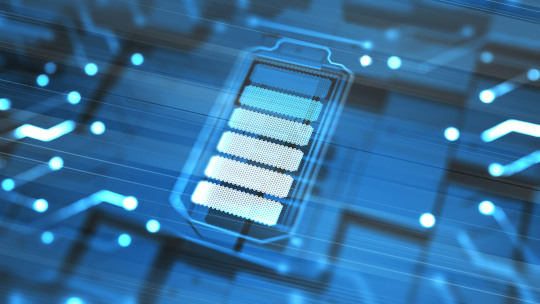
The competitive analysis of the Lithium Battery Charge Management Chip Market include a comprehensive analysis of market trends, competitor landscape, consumer behavior, and potential opportunities. It should cover key demographics, market size, growth projections, and risk factors. The report should also highlight the methodology used for data collection and analysis, presenting findings with visual aids such as charts and graphs. Additionally, recommendations and strategic insights for stakeholders to make informed decisions are crucial. The report should be concise, well-organized, and provide actionable information for businesses aiming to navigate the market effectively.
Key Function:
A Lithium Battery Charge Management Chip market research report serves to assess market dynamics, identify opportunities, and mitigate risks for businesses. It analyzes consumer preferences, competitor strategies, and economic trends. The report facilitates informed decision-making by presenting data on market size, growth potential, and emerging patterns. It aids in product development, pricing strategies, and market positioning. Additionally, market research reports help businesses understand their target audience, enhance marketing efforts, and optimize resource allocation. By offering actionable insights, these reports empower organizations to stay competitive, adapt to changing market conditions, and foster sustainable growth in a dynamic business environment.
Key Dynamics:
Market research reports capture vital dynamics, including market trends, competitive analysis, and consumer behavior. They reveal market size, growth projections, and regional nuances. SWOT analysis examines internal strengths and weaknesses, along with external opportunities and threats. Consumer insights delve into preferences, impacting product development and marketing strategies. The competitive landscape unveils key players, strategies, and market shares. Regulatory factors and industry challenges are explored, aiding risk assessment. Timely and accurate information empowers businesses to adapt strategies, capitalize on opportunities, and navigate challenges, ensuring informed decision-making and sustained competitiveness in dynamic markets.
Receive the FREE Sample Report of Lithium Battery Charge Management Chip Market Research Insights @ https://stringentdatalytics.com/sample-request/lithium-battery-charge-management-chip-market/8344/
Market Segmentations:
Global Lithium Battery Charge Management Chip Market: By Company
• Analog Devices
• Texas Instruments
• STMicroelectronics
• NXP
• Renesas
• Cypress Semiconductor
• Microchip
• Renesas Electronics Corporation
• LAPIS Semiconductor
• Intersil
• ROHM
• Petrov Group
• Hycon Technology
• Diodes Incorporated
• Fujitsu
• Semtech
• Vishay
• ON Semiconductor
• Sino Wealth Electronic Ltd.
Global Lithium Battery Charge Management Chip Market: By Type
• SL1053
• TP4056
• HL7016
• CS0301
• Others
Global Lithium Battery Charge Management Chip Market: By Application
• Consumer Electronics
• Industrial
• Automotive
• Other
Regional Analysis of Global Lithium Battery Charge Management Chip Market
All the regional segmentation has been studied based on recent and future trends, and the market is forecasted throughout the prediction period. The countries covered in the regional analysis of the Global Lithium Battery Charge Management Chip market report are U.S., Canada, and Mexico in North America, Germany, France, U.K., Russia, Italy, Spain, Turkey, Netherlands, Switzerland, Belgium, and Rest of Europe in Europe, Singapore, Malaysia, Australia, Thailand, Indonesia, Philippines, China, Japan, India, South Korea, Rest of Asia-Pacific (APAC) in the Asia-Pacific (APAC), Saudi Arabia, U.A.E, South Africa, Egypt, Israel, Rest of Middle East and Africa (MEA) as a part of Middle East and Africa (MEA), and Argentina, Brazil, and Rest of South America as part of South America.
Click to Purchase Lithium Battery Charge Management Chip Market Research Report @ https://stringentdatalytics.com/purchase/lithium-battery-charge-management-chip-market/8344/
Reseason To Purchase:
Purchasing a market research report is essential for businesses seeking a competitive edge. It provides in-depth insights into market trends, consumer behavior, and competitor strategies. This knowledge empowers informed decision-making, mitigates risks, and identifies growth opportunities. Market reports streamline strategic planning, enhance product development, and optimize resource allocation. For businesses entering new markets, these reports offer critical data for successful market entry. Additionally, the comprehensive analysis instills investor confidence, ensures regulatory compliance, and saves time compared to independent research efforts. Ultimately, investing in market research reports is a strategic move that enhances efficiency, minimizes uncertainties, and fosters sustainable business growth.
About Stringent Datalytics
Stringent Datalytics offers both custom and syndicated market research reports. Custom market research reports are tailored to a specific client's needs and requirements. These reports provide unique insights into a particular industry or market segment and can help businesses make informed decisions about their strategies and operations.
Syndicated market research reports, on the other hand, are pre-existing reports that are available for purchase by multiple clients. These reports are often produced on a regular basis, such as annually or quarterly, and cover a broad range of industries and market segments. Syndicated reports provide clients with insights into industry trends, market sizes, and competitive landscapes. By offering both custom and syndicated reports, Stringent Datalytics can provide clients with a range of market research solutions that can be customized to their specific needs.
Reach US
Stringent Datalytics
+1 346 666 6655
Social Channels:
Linkedin | Facebook | Twitter | YouTube
0 notes
Text
Power Supply for Espressif Module with Battery Charger & Boost Converter
We will discuss the integration of a power supply for the ESP32 Board. Additionally, we will add a Boost Converter Circuit to enable the use of a 3.7V Lithium-Ion Battery for powering the ESP32. Since Lithium-Ion Batteries can discharge, we will integrate a Battery Charger Circuit along with a Battery Management System. Many Lithium-Ion/Lithium Polymer Batteries can only charge up to 4.2V, which is low for the ESP32 Board.
Therefore, we need to increase the battery voltage from 2.8V-3.7V to 5V. This necessitates the use of a compact Boost Converter Module build with inductors, ICs, and resistors. To facilitate battery charging and management, we will use the TP4056 Battery Charger Module. Alternatively, we can also power the circuit using a 9V/12V DC Adapter. The LM7805 Voltage Regulator IC restricts the voltage to 5V. If you are not going to use a battery for power, you can utilize the DC Power Adapter or a 9V Battery.
ESP32 Power Requirement
The ESP32 Board’s operating voltage is between 2.2V to 3.6V. But we can supply 5V from the Micro-USB port. For applying 3.3V there is already an LDO voltage regulator on the module to keep the voltage steady at 3.3V. ESP32 can be powered using Micro USB port and VIN pin (from external supply).
The power requirement of ESP32 is 600mA of that ESP32 pulls only 250mA during the RF transmissions. When it is performing boot or wifi operation it’s drawing more than 200mA current. Thus supplying power from Micro-USB Cable is not enough for ESP32 Board when we need to add multiple sensors or modules to the Board. This is because Computer USB port can provide less than 500mA of current. Check more on power requirements of ESP32 here ESP32 Datasheet.
Hardware Requirements
Following are the components required for making this ESP32 Power Supply project. You can get all the components from our Campus Component store.
ESP32 Board-ESP32 ESP-32S Development Board (ESP-WROOM-32)
Battery Charger Module-TP4056 5V,1A Battery Charging Module
Voltage Regulator IC-LM7805 5V IC
Female DC Power Jack-DCJ0202
Step-Up Boost Converter Module-3.7V to 5V Boost Converter Module
Switch-3 Pin SPDT Switch
Electrolytic Capacitor-470uF, 25V
Electrolytic Capacitor-100uF,16V
LED-5mm LED Any Color
Resistor-220 ohm
3.7V to 5V Step-Up Boost Converter Module
The above shown is the Step-Up DC-DC Boost converter module which provides 5V DC stable voltage output for various input ranges between 1.5V to 5V. This small tiny circuit boosts the voltage level and provides the amplified stabilized 5V output. This module operates at a frequency of 150KHZ. It utilizes varying amounts of current to generate a balanced output for different input ranges.
Read more about Boost Converter
1. Input 1-1.5V, output 5V 40- 100mA
2. Input 1.5-2V, output 5V 100-150mA
3. Input 2-3V, output 5V 150-380mA
4. Input more than 3V, output 5V 380-480mA.
TP4056 Battery Charger Module
The TP4056 module is designed specifically for charging rechargeable lithium batteries through the constant-current/constant-voltage (CC/CV) charging technique. Apart from ensuring the safe charging of lithium batteries, the TP4056 BMS Board incorporates essential protection mechanisms for lithium batteries. It is compatible with both USB power and adapter power supplies. Also because of its internal PMOSFET architecture and anti-reverse charging path, there is no need for external isolation diodes.
TP4056 Module Datasheet.
Power Supply for ESP32 with Battery Charger & Boost Converter
The circuit can be powered by using two methods, one with 9V/12V DC Adapter and other with 3.7V Lithium-Ion Battery.
To power the board through the DC Jack, we've added here a DCJ0202 Female Jack. Also we have added 470uF and 100uF Electrolytic Capacitors that serve to lower the DC fluctuations and eliminate voltage spikes. The LM7805 Voltage Regulator IC is capable of handling input voltages ranging from 7V to 35V, although it's advisable to stay within the 15V limit. Higher input voltages result in increase in heat dissipation thus we have to add a larger heat sink. Connecting the Voltage regulator's output to the Vin pin of the ESP32 and grounding it ensures the module can be powered using a 9V/12V DC Adapter or a 9V Battery.
Alternatively, if opting not to utilize a DC Adapter for ESP32 power, a 3.7V Lithium-Ion or Lithium Polymer Battery can be used. Utilizing the Boost Converter Module, the 3.7V is increased to 5V, operating within the 2.8V to 4.2V input range. The boosted 5V is connected to a switch, and the switch is linked to the 5V Vin pin of the ESP32. The Battery terminal is also connected to the output terminal of the TP4056 Battery Charger Module, allowing the battery to be charged using a 5V MicroUSB Data Cable.
Conclusion
Thus by including a Battery Charger and Boost Converter to power up the esp32, we can create a flexible and efficient power for the unique requirements of the ESP32 platform. Reach out to the Campus Component- an electronics parts suppliers today, if you are building a Battery charger, Boost converter and looking for electronic components such as ESP32 and other microcontrollers from trusted brands such as Mornsun, Espressif, AIT, IKSEMI other components.
0 notes
Text
Simple DIY 18650 Battery Charger - TP4056 Review (Everything Explained)
https://nerdclips.com/simple-diy-18650-battery-charger-tp4056-review-everything-explained/
Simple DIY 18650 Battery Charger - TP4056 Review (Everything Explained)
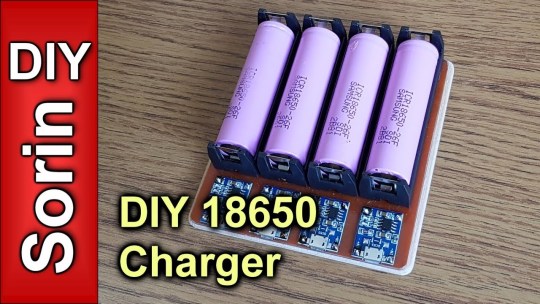
0 notes
Text
Price: [price_with_discount]
(as of [price_update_date] - Details)
[ad_1]
Product Description
Pam8403 Amplifier Board PAM8403 mini digital amplifier board, unique class D digital powerless board with non-LC filter, can be powered directly from the computer's USB. Operating voltage: 2.5V-5.5V Dual-channel stereo, 5V power supply can output 3W +3 W power, can be directly driven 4Ω, 8Ω small speakers, the output power, enough energy, good sound quality.
TP4056 Charging Module Charge your lithium battery with the TP4056 Battery Charging Module! Simply connect the ends of the battery to the BAT+ and BAT- terminal of the module and power the module with a 5V power supply from the micro USB port. The module is basically made for charging rechargeable lithium batteries using the constant current/constant voltage charging method. Input Voltage: 4.5V to 5.5V
Bluetooth Stereo Audio Receiver This is a Bluetooth audio receiver module, transmitting MP3 and other common audio formats' audio signals. It's simple to set up and use, and once connected to another Bluetooth system such as your phone or laptop, it can receive and translate signals into an output format compatible with speakers. It has three output terminals: L Out, R Out, and GND, to which you can attach a wired earphone through a 3.5mm female jack, or connect its output to the input of a good amplifier device to drive a large speaker.
Name
Electronic Spices Electronic Spices Electronic Spices Electronic Spices Electronic Spices
Quality
✓
✓
✓
✓
✓
Includes
Pam8403 Pam8403 and Bluetooth FM AUX USB TP4056 Pam8403 and Internal Speaker Pam8403 and volumeController
Channel
2 2 none 2 2
Power Source
DC DC DC DC DC
Charger Module Micro :-Charge and Discharge Protection Module, Input Voltage: DC 5V, End-of-Charge Voltage: 4.2V +/- 1%, Max Charge Current: 1000mA
PAM8403:- Super mini volume: 1.85 x 2.11 cm.Can be easily placed in a variety of digital products within a small space, high efficiency amplification
BLUETOOTH MODULE:- Input Volt - 5 V DC, Audio Out : L R G (it must be connected to amplifire)
Allows you to play songs to your speakers directly from your phone, Compact and Small can be powered with usb wall power adapter
[ad_2]
0 notes
Text
TP4056 1A Li-ion lithium Battery Charging Module Type C
Input interface: Type C
Current Protection: no
Price:- 33.00 EGP
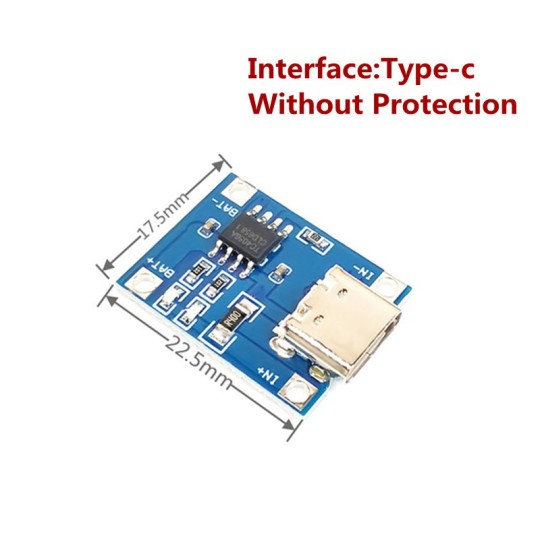
0 notes
Video
youtube
TP4056 Модуль Для Зарядки Литий-Ионных и Литий-Полимерных Аккумуляторов ...
0 notes
Text
Как Заработать на войне в Украине?
Война - это лучшее время для бизнеса ,вы можете продать все то,что в обычное время никто не купит и по большой, завышенной цене .

В обычное время , такие товары как повер банк или аккумуляторы не актуальны . Единственное где их можно использовать , это путешествия. Путешествия редко длятся долго , и потому такие устройства мало покупают . Следует отметить что часто в Power bank используют повышающие схемы , это импульсные схемы, на блокинг генераторах для повышения с 3,7 вольт до 5 вольт ,в ряде устройство такие схемы не очень желательны, проще применять два акамулятор последовательно с понижением питания например на КР142ЕН5 А

или на одном транзисторе и стабилитроне , такая схема дешевая ,минимум компонентов и стабильная

но при этом требуется два аккумулятора что делает дорогим само зарядное устройство .
Часто используется схема повышения напряжение что бы ставить только одну батарею .

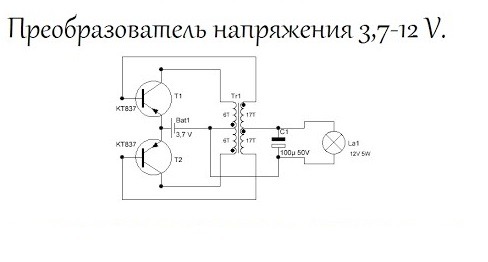

таких схем много . На самом деле есть микросхема , которая делает тоже самое .


Как видим схемы очень простые , или понижающая схема или повышающая на всего одном транзисторе и микросхеме и пару навесных , и типовая плата Заряда .

часто используют дешевые платы контролера от батарей для мобильных телефонов , но есть очень дешевые и под литион

Существует много готовых решений на микросхемах TP4056

Если вы внимательно посмотрите , то совсем недавно корпус Power bank
стоил всего 21 гривны . Однако сейчас цены дошли до 100 гривен и в наличии их нет . Мы видим пяти кратный рост цен .
При этом в Украине проблема со светом и есть спрос на этот мало нужный товар .
Следовательно можно сделать более дешевые повербанки или торговать корпусами для них .
Что нужно учесть?

У вот таких повер банков , есть проблема . Микросхемы могут не подойти . Потому есть смысл делать корпус чуть иначе , без микросхем.
То есть поставить только выход USB и вход , и у вас будет корпус и 4 провода к USB ,а так же два провода от самой батареии , сами же платы ставить не нужно . Но нужно учесть что сюда должна стать как минимум типовая TP4056 и если это один акамулятор то типовая Dc-dc повышающий преобразователь 5в usb


то есть в Идеале вы можете делать просто корпус под аккумулятор с заглушками .
И продавать сам корпус , без чипов , только с контактами под акамулятор , или делать самостоятельную сборку.
Риск для бизнеса .
Война может длиться не очень долго , и свет в Украине может нормализоваться,таким образом это кратко срочный бизнес сроком до одного года . Это рентабельный бизнес поскольку вы поднимаете цену в 500% от начальной стоимости .
0 notes
Link
Carregador de bateria LIR2032 com TP4056 https://www.te1.com.br/?p=43898 Por Toni Rodrigues Toni Eletrônica Circuitos...
0 notes
Photo

For new project #rtcmodule #arduino #promini #switch #liion #liionbattery #tp4056 #tp4056charger #charger #module #electronics #tech #diy #basicelectronics #booster #voltagebooster #components #circuit https://www.instagram.com/p/Ciu0miWvB7Y/?igshid=NGJjMDIxMWI=
#rtcmodule#arduino#promini#switch#liion#liionbattery#tp4056#tp4056charger#charger#module#electronics#tech#diy#basicelectronics#booster#voltagebooster#components#circuit
0 notes
Text
Solving a Hot and Sticky situation.
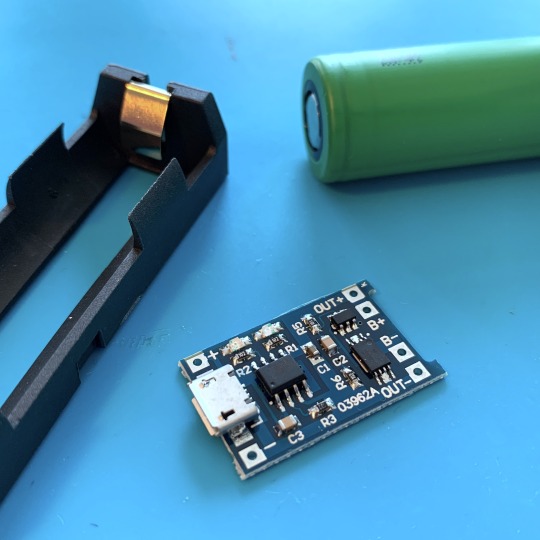
In the past few weeks, life got a little bit in the way of my maker-hobby. To make sure I got my monthly doses of tinkering, I decided to take on a quick and fun one hour project this weekend: solving a hot and sticky situation.
A few weeks ago I quickly fabricated a simple 18650 charger by soldering a TP4056 charging module to a Keystone battery holder. I used my hot glue gun to keep everything together.
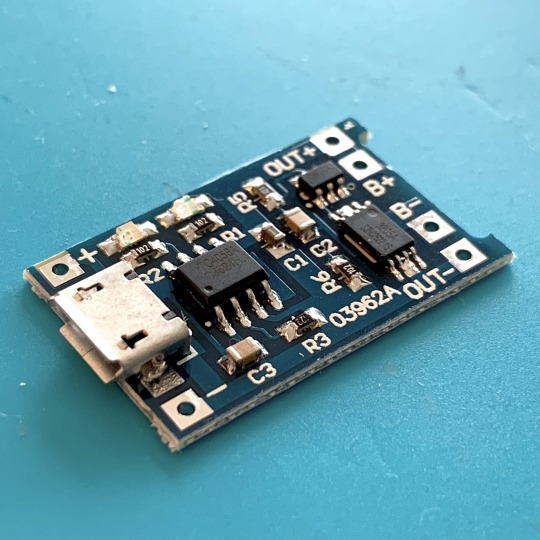
Not my brightest moment: the TP4056 charger module gets VERY hot, resulting in melting glue. Ending up with a desk full of glue after the 18650 battery was charged. I facepalmed so hard, I forgot to take a picture of the hot and sticky situation.
3D-Printing to the rescue!
Owning the 3D printer, the only obvious solution is to print a mount for the 18650 Keystone holder and the TP4056 module. If you search Thingiverse, you'll find a lot of these mounts, but of course there is no fun in downloading a ready made model.
Let's design my own version!
To make things easy, I've downloaded a model of the Keystone holder as well as the TP4056 module from GrabCad.

After importing the step files into Fusion 360, I place the models as desired, allowing me to design a holder around them.
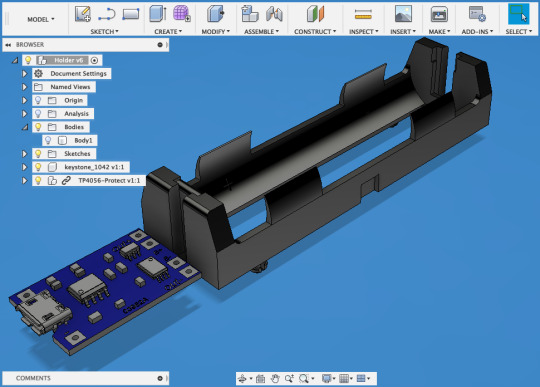
With a few sketches and extrusions, the holder begins to take shape.
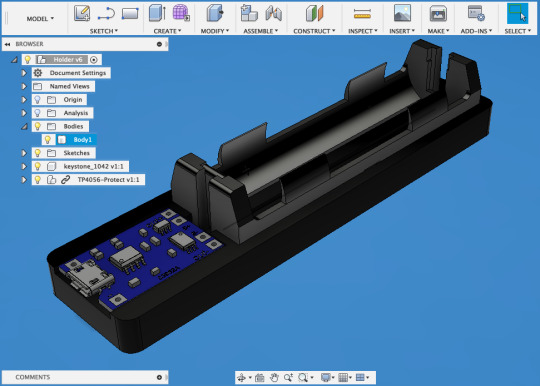
After adding some mounting holes and and slot for the wires. The design is ready to be printed.
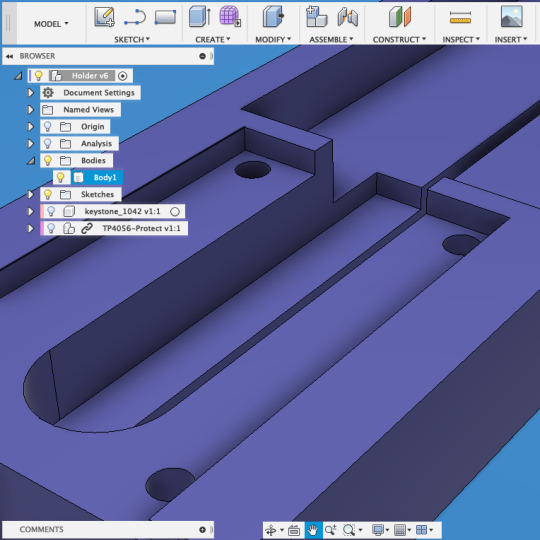
Aside from some minor slicing issues at one of the corners of the design, my Lulzbot Mini did a fine job of printing the design I just made.

Time to put everything together!
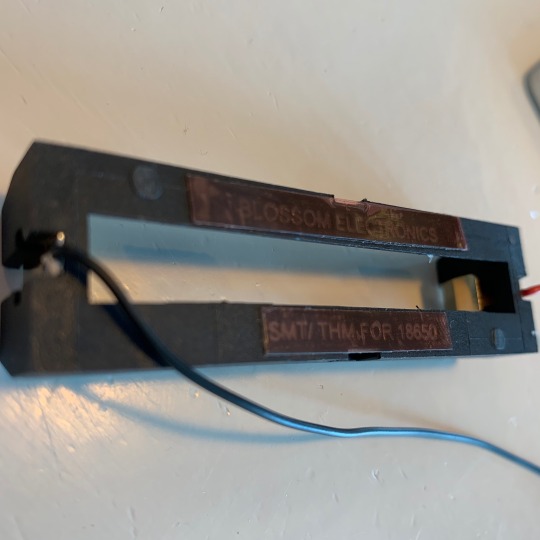
The Keystone holders I use don't have the little trough hole mounting pins, so I used a few pieces of double sided tape to keep the holder in place. I also soldered two wires to the connectors. And soldered those wires to the battery connection points of the TP4056 module.
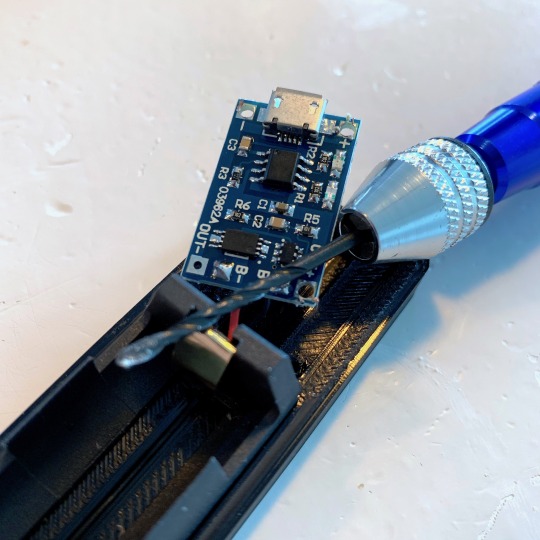
Because I wanted to use 4 screws to mount the TP4056 module, I needed to use a little drill to make the holes a bit wider. After drilling I cleaned up the burs. And more importantly: after screwing the module into place I checked for shorts using my multimeter because I used metal screws. Everything good to go!

Time to start using this handy little fella!
If you want to print this mount yourself, check out the STL file on Thingiverse. Happy Printing!
4 notes
·
View notes
Text

Photo of the day: TP4056 lithium charging module with circuit protection.
1 note
·
View note
Text
DIY - BMS Protection Board made with TP4056 modules
https://nerdclips.com/diy-bms-protection-board-made-with-tp4056-modules/
DIY - BMS Protection Board made with TP4056 modules
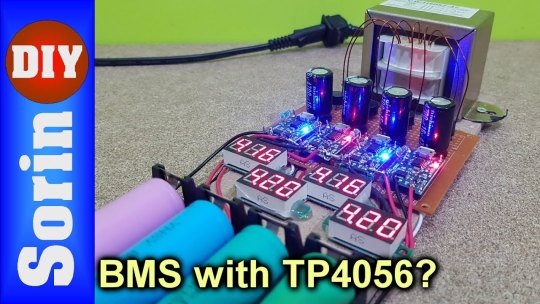
0 notes
Photo
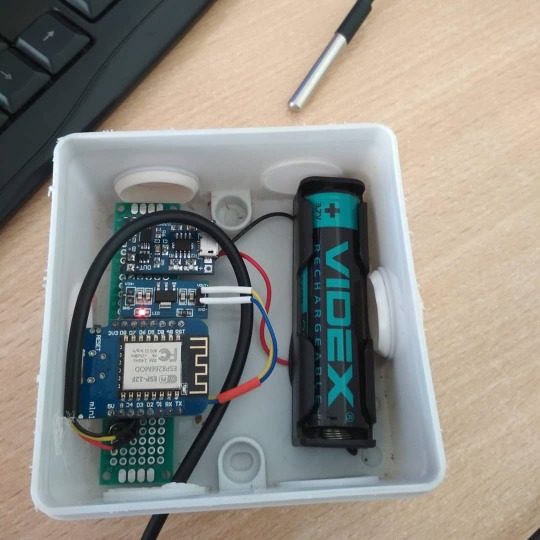
Простой логгер температуры #ds18b20 с аккамулятором для облачного сервиса @thinger.io Удобные монтажные коробки для уличного применения или агрессивных сред.🧪 Не дорого и просто. Зарядник #tp4056 + преобразователь 3.3В.🔨 #esp8266 . . . #aelmaker #датчик #arduinobasics #arduinorobot #arduinostarterkit #arduinoide #arduinoindonesia #arduinoproject #датчиктемпературы #arduino #arduinoprojects #arduinoboard #arduinocnc (Kiev, Ukraine) https://www.instagram.com/p/CM3_lhhL0tF/?igshid=1dj4or4214s2m
#ds18b20#tp4056#esp8266#aelmaker#датчик#arduinobasics#arduinorobot#arduinostarterkit#arduinoide#arduinoindonesia#arduinoproject#датчиктемпературы#arduino#arduinoprojects#arduinoboard#arduinocnc
0 notes
Video
youtube
DIY - SOLAR BATTERY CHARGER
Hi Everyone, I am back again with this new tutorial.In this tutorial, I am going to show you how to charge a Lithium 18650 Cell using TP4056 chip utilizing the solar energy or simply the SUN.
Wouldn’t it be really cool if you can charge your mobile phones battery using the sun instead of a USB charger? You can also use this project as a DIY portable power bank.
The total cost of this project excluding the battery is just under $5. The battery will addup another $4 to $5 bucks. So the total cost of the project is some what around $10. All components are available on my website for sale for really good price, the link is in the description below.
2 notes
·
View notes